OPOD - Lowitz Arc over California
OPOD - Lowitz Arc over California: A Rare Atmospheric Phenomenon
The Lowitz Arc, a fascinating atmospheric optical phenomenon, was captured in all its brilliance over California by Andrew Kirk on September 13th, 2012. The rarity of such clear examples of Lowitz arcs makes this sighting truly remarkable. Let's delve deeper into the intricacies of this captivating atmospheric display.
Traditionally, Lowitz arcs were doubted and considered elusive due to their scarcity. These arcs were first recorded by Lowitz himself in 1790, as small arcs extending sunwards from the sundogs and merging with the 22° halo. The infrequent observations of Lowitz arcs may be attributed to their association with the 22° halo, making them less noticeable and easily overlooked.
The upper Lowitz arc is more commonly observed, as seen in Andrew Kirk's photograph, where it curves downwards from an upper Parry arc, crosses the upper tangent arc, and eventually merges with the 22° halo. This configuration gives the arc a distinct appearance and adds to its visual allure.
To better understand the formation of Lowitz crystal arcs, we can turn to HaloSim ray tracing. In the ray tracing diagram, the Lowitz crystal arcs are depicted in red. The arcs near the sundogs are particularly prominent since traditionally oriented Lowitz crystals were used. However, in Andrew Kirk's display, the crystals may have been columnar and rocking back and forth around the Parry orientation. This preference for the upper arc explains why arcs near the sundogs were not observed.
Intriguingly, the HaloSim rays tracing also reveals the presence of additional Lowitz arcs located approximately 46° from the sun. These arcs originate from rays passing between a hexagonal end face and a prism side face. In one of Andrew Kirk's images, fragments of a double arc in this region can be observed. The outer arc could potentially be an ordinary supralateral arc or a rare Parry supralateral arc. The inner arc, on the other hand, may be a fragment of a 46° Lowitz arc. Another possibility is that the inner arc is a small segment of a 46° halo. The true nature of these arcs remains uncertain and open to interpretation.
It is crucial to avoid over-analyzing or speculating based solely on a single image. The complexity and variability of atmospheric phenomena necessitate careful observation and the collection of multiple photographs to gain a comprehensive understanding.
When encountering such captivating atmospheric displays, it is essential to take the time to observe and photograph the sky beyond the showpiece halos. Often, unexpected and extraordinary phenomena can be discovered by exploring the broader skyscape.
In conclusion, the sighting of the Lowitz Arc over California provides a rare glimpse into the world of atmospheric optics. Its unique characteristics and association with other optical phenomena make it a subject of fascination for researchers and enthusiasts alike. By continuing to observe and document these elusive displays, we can expand our knowledge and appreciation of the wonders that unfold in the skies above us.
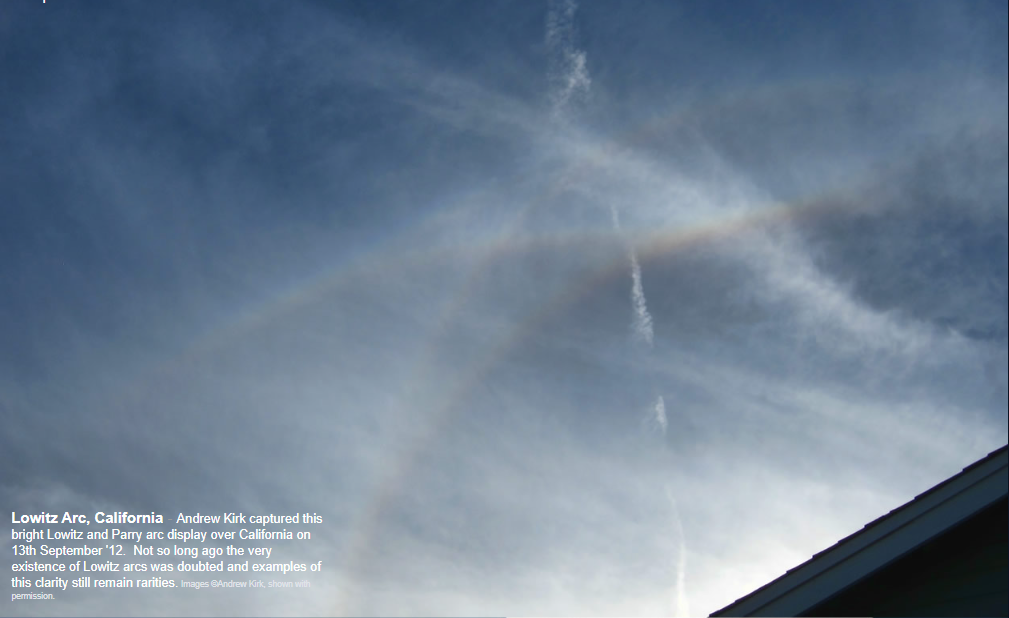
Lowitz Arc, California - Andrew Kirk captured this bright Lowitz and Parry arc display over California on 13th September '12. Not so long ago the very existence of Lowitz arcs was doubted and examples of this clarity still remain rarities. Images ©Andrew Kirk, shown with permission.
The traditional place to search for Lowitz arcs is, where Lowitz first recorded them in 1790, as small arcs extending sunwards from the sundogs and joining the 22° halo. That is perhaps one reason why they were so rarely observed.
The upper Lowitz arc is more frequently seen, as here, curving downwards from an upper Parry arc - crossing the upper tangent arc - and then merging with a 22° halo.
The HaloSim ray tracing at right shows Lowitz crystal arcs in red. Arcs near the sundogs are prominent because traditionally oriented Lowitz crystals were used. Those in Andrew Kirk's display might have been columnar and rocking back and forth around the Parry orientation. This strongly favours the upper arc that was observed. There is no evidence - see lower image - of arcs near the sundogs.
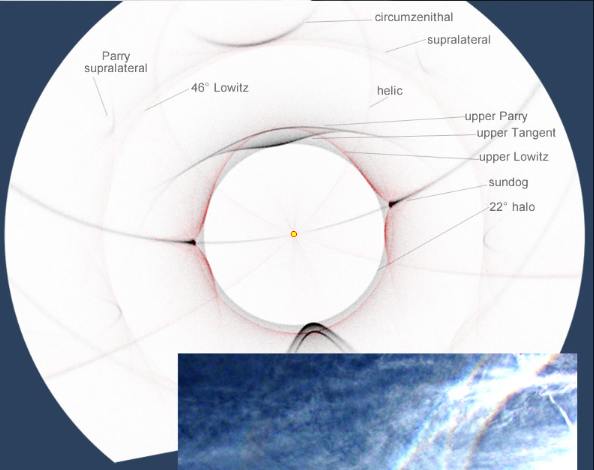
The HaloSim rays tracing shows extra Lowitz arcs approximately 46° from the sun. These are from rays passing between a hexagonal end face and a prism side face. One of Andrew Kirk's images - enhanced at right - shows fragments of a double arc in this region. It is dangerous to over-analyse or speculate on a single image. However, the outer arc might be an ordinary supralateral arc - or a rare Parry supralateral. The inner arc might be a 46° Lowitz arc fragment. Another possibility is that the latter is a small part of a 46° halo.
We shall likely never know. As here, always take time to observe and photograph the sky away from the showpiece halos!
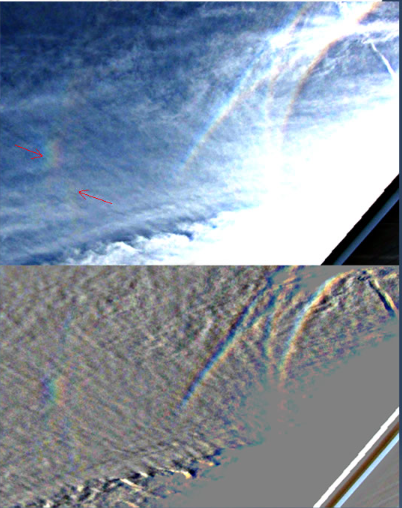
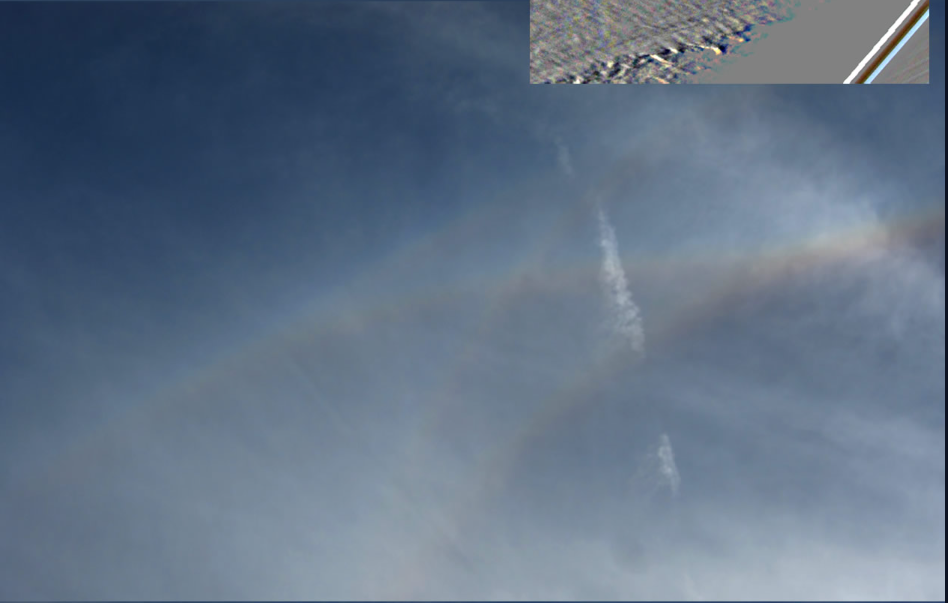
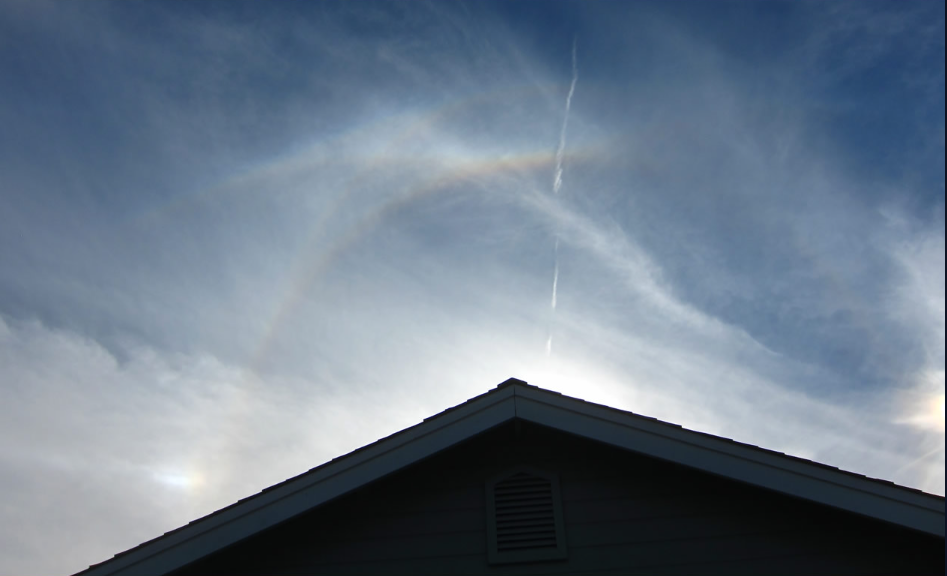
Note: this article has been automatically converted from the old site and may not appear as intended. You can find the original article here.
Reference Atmospheric Optics
If you use any of the definitions, information, or data presented on Atmospheric Optics, please copy the link or reference below to properly credit us as the reference source. Thank you!
-
<a href="https://atoptics.co.uk/blog/opod-lowitz-arc-over-california/">OPOD - Lowitz Arc over California</a>
-
"OPOD - Lowitz Arc over California". Atmospheric Optics. Accessed on December 22, 2024. https://atoptics.co.uk/blog/opod-lowitz-arc-over-california/.
-
"OPOD - Lowitz Arc over California". Atmospheric Optics, https://atoptics.co.uk/blog/opod-lowitz-arc-over-california/. Accessed 22 December, 2024
-
OPOD - Lowitz Arc over California. Atmospheric Optics. Retrieved from https://atoptics.co.uk/blog/opod-lowitz-arc-over-california/.